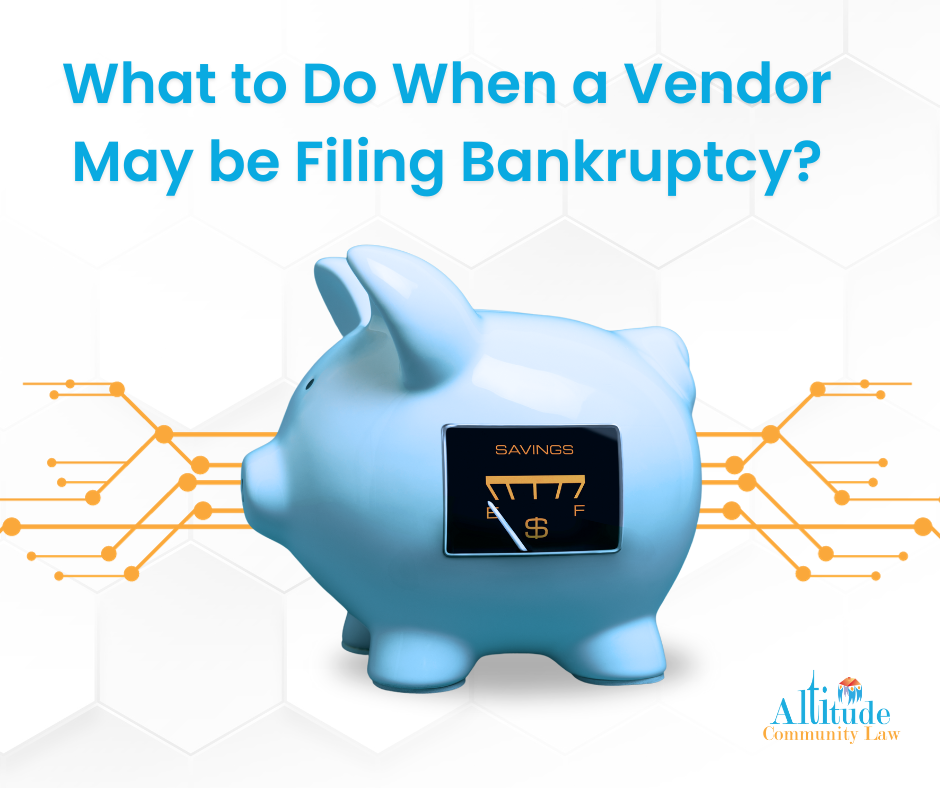
With continued inflation, rising costs of materials, and the volatility of our current economy, we continue to experience financial impacts to community associations, including the impact to an association when one of its vendors decides to file bankruptcy.
There are a few different types of bankruptcy a vendor may file and different processes or outcomes that may occur depending upon the bankruptcy filed, but for our larger business vendors, we can usually anticipate that it will be a Chapter 7 Bankruptcy (often referred to as a “Liquidation”) or a Chapter 11 Bankruptcy (you’ll likely recognize the term for Chapter 11 as “Reorganization”).
While each bankruptcy has its own processes, there are some general steps that an association can take in order to ease the impact of the vendor’s bankruptcy filing on the association, its manager, the board, and the community.
Prebankruptcy Filing. If a vendor has made the association aware that its bankruptcy filing is imminent, then we recommend that the association do the following:
- Advise the association’s attorney that it has received word that one of its vendors intends to file bankruptcy
- Gather the following:
- Contracts, leases or agreements with vendor;
- Contracts, leases or agreements with subcontractor(s) if any;
- Spreadsheet of any deposits paid to vendor, showing date of payment and amount paid;
- Paid invoices with proof of payment;
- Unpaid invoices (include summary of outstanding fees that the association believes it will be invoiced in the future);
- Summary of remaining work needing to be completed under the current contract, lease or agreement;
- List of materials and/or property (as applicable) that vendor has purchased or created on behalf of the association;
- Copies of any liens that have been filed as part of the vendor’s pending project with the association.
- Set up a meeting with the association’s attorney to discuss a plan of action regarding the pending project and potential next steps. Each association’s situation will be unique because different projects may be in different stages of completion, there may be subcontractors or County or City planning and permitting departments involved, or there may be other vendors who are awaiting completion of a portion of the project before those vendors are able to proceed with the work designated to them under other contracts with the association.
Actions to Take if Association Receives a Notice of Bankruptcy Filing. If a vendor does file bankruptcy and lists the association in the bankruptcy filing, the association will receive notice from the Bankruptcy Court that a bankruptcy was filed. The notice will contain the date the bankruptcy was filed and list other important and time sensitive deadlines by which the association may need to act. Here are recommended steps after an association has received a notice of bankruptcy filing:
- Send the notice to the association’s legal counsel as soon as possible since there are very strict deadlines that come into play under the bankruptcy code and some of those deadlines begin running as soon as the case is filed;
- Send all information gathered in the prebankruptcy filing stage to the attorney as well, since the attorney will need that information to review and prepare certain bankruptcy documents on behalf of the association (such as proofs of claim);
- Immediately stop any collection action or action in furtherance of collection if applicable (e.g. if the vendor owes the association money, do not call the vendor to collect – this will be a violation of the automatic bankruptcy stay, which is the hold that is placed on any type of collection activity against the entity or person that has filed bankruptcy).
- Do not continue on with the project by pretending no bankruptcy has been filed because the vendor, as well as the vendor’s contracts and assets, are now considered part of the bankruptcy estate. This includes cancelling the contract with the vendor after the vendor has filed bankruptcy.
Post-Bankruptcy Filing Steps:
- File a proof of claim if applicable: If the vendor owes the association money or property, then a proof of claim must be filed with the bankruptcy court and it must be filed on or before the proof of claim filing deadline;
- Additional actions: Determine whether there may be additional actions the association can or should take by speaking to your legal counsel regarding individual circumstances and current vendor contract. Such actions could include attendance at the creditor meeting, voting to accept or reject a bankruptcy plan, filing various motions for relief and/or approval with the court, etc.
Altitude Community Law, P.C. is happy to meet with you to evaluate and potentially assist you with any bankruptcy filings or questions about bankruptcy that you may have. Please contact attorney Amanda K. Ashley, a partner at Altitude with experience in bankruptcy actions, at [email protected] or 303-991-2012 for further information.